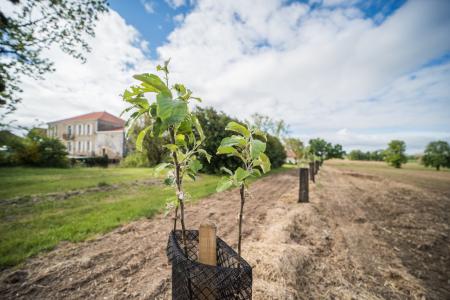
Area characterisation:
The farm is located in the river basin of the Seudre, in the heart of the Saintonge agricultural area in the Charente-Maritime department. The farm grows field crops and vines and has been converting to organic farming since 2019. The effects of climate change and conventional, even intensive, farming practices are having an ever-greater impact on the ability to ensure sustainable, resilient agricultural production. Whether in terms of soil erosion, loss of organic matter or water availability, the signs are alarming and require adapting agricultural practices. The objectives of the project are to develop a resilient agroforestry farm that can diversify traditional production, foster functional biodiversity and create a pleasant living environment in which trees play their full part in the agricultural landscape while acting as a climate regulator.
Objective:
- For adapting to climate change : preventing soil erosion and securing water resources.
- For biodiversity : encouraging functional and heritage biodiversity and creating habitats conducive to the development of beneficial organisms.
- For the local area : improve the landscape and living environment and diversify sources of income for the farm.
Financing:
- CDC Biodiversité Nature 2050 Programme : 16 650 €
- Departmental Council : 6 432 €
- Region : 5 880 €
- Own funds : 27 436 €
Total budget : 56 398 €
In addition, the cost of maintaining and monitoring the project until 2050 will be covered by the Sœurs du Maine and CDC Biodiversité.
Potential impacts/benefits:
BENEFITS REGARDING TARGETED ADAPTATION ISSUES
- Improving the resilience of farming systems to climatic variations by improving the water storage capacity of soils and their organic content.
BENEFITS FOR BIODIVERSITY
- Increasing the number of habitats favourable to biodiversity.
OTHER BENEFITS
- Diversifying the farm’s traditional production by introducing fruit juice-and sap-producing trees into the system. • Producing timber for local use.
Actions:
The farm’s overall plan is to gradually set up an agroforestry system based on planting trees including (fruit trees, birch, timber, etc.) to support existing production during the transition to organic farming and to develop new produce (fruit juice, birch sap). The works, which started in 2019, have involved :
- Gradually setting up anagro-forestry system (fruit trees, birch trees, timber, etc.) both to consolidate existing production during the transition to organic farming and to develop new produce (fruit juice, birch sap),
- Planting 3 042 saplings of around 30 different species over 43 hectares to create a variety of landscapes,
- Creating and setting up discontinuous linear features; hedges; intra-plot planting; intra plot fruit trees and copses.
Lessons learnt:
TECHNICAL ASPECTS AND PROJECT DESIGN
- Soil preparation : For the hedgerows and intra plot features, deep subsoiling was carried out on the planting line. The existing vegetation was then destroyed before preparing the seedbed for planting the grass strip. For fruit trees, birch trees and tree rows, the soil was worked in planting holes using a mechanical shovel, without mixing the soil horizons, and with the addition of composted manure.
- Mulching : Wood chips or straw from the farm at the foot of each tree.
- Intra-plot planting : Two lines of trees spaced 4m between rows and 5m between plants, replicated every 42m. The rows are planted on an 8m wide grass strip with a 36m cultivation area. There are two fallow areas on either side of the cultivation plot.
- Planting of hedgerows : Fruit trees planted every 5 m on a 10 m wide grassy strip. Three-layered double hedges (conifers, Scots pine, birch).
- Tree species : The species chosen are adapted to the soil and climate conditions and are selected to provide complementary uses (timber, firewood, hardiness and multiple fruiting periods) and to promote biodiversity.
- Protection from wild animals : 1.2 m high sheaths held by two 1.5 m acacia stakes were set up. Sheep fat (a natural repellent) was sprayed on fruit trees and hedgerows (Hornbeam, Service Tree, Wild Cherry, Small-leaved Lime, etc.). Electric fencing.
- Maintenance : Medicinal and aromatic plants are grown in the strips under the trees to reduce the need for manual weeding.
STAKEHOLDER COMMITMENT
- Training : project with the Saint Antoine Agricultural Highschool to create training courses for adults.
MONITORING AND REPLICABILITY OF THE ACTION
- Promoting the project to the general public : Ultimately, Isabelle wants to share her passion, her profession and her vision of eco-responsible farming by opening her farm to tourists, local stakeholders and schoolchildren.
- Progressiveness : The farm is striving to maintain its financial stability, currently supported by wine production, while adopting agroecological practices
Organisations:
- Sœurs du Maine
- Nature 2050 Programme – CDC Biodiversité
- Chamber of Agriculture
- Agricultural training institutions
- Charente-Maritime Organic Farmers’ Association (GAB 17)
- Birds Protection League (LPO)
- « Farmer of the Future » competition 2019
Contacts:
Nature 2050 – Programme & Fonds nature2050@cdc-biodiversite.fr
Global goals:
-
13. Climate action
-
15. Life on land
NBS benefits:
- Developing climate change adaptation; improving risk management and resilience
- Flood peak reduction
- Increase infiltration / Water storage
- Increasing infiltration
- Reduce drought risk
- Reduce flood risk
- Reduce risk of damages from drought
- Reduce run-off
- Reducing temperature at meso or micro scale
- Developing climate change mitigation
- Carbon sequestration and storage
- Restoring ecosystems and their functions
- Increase Biodiversity